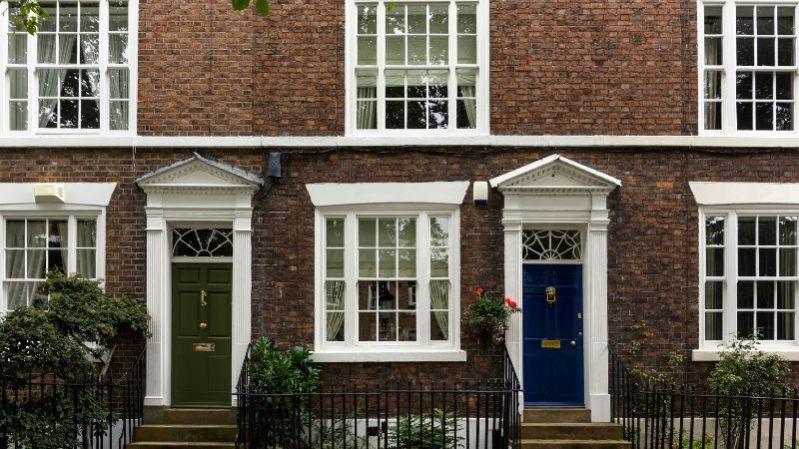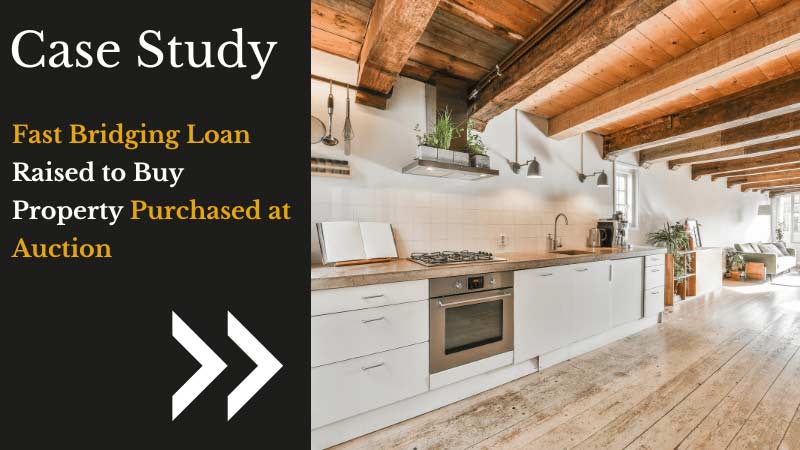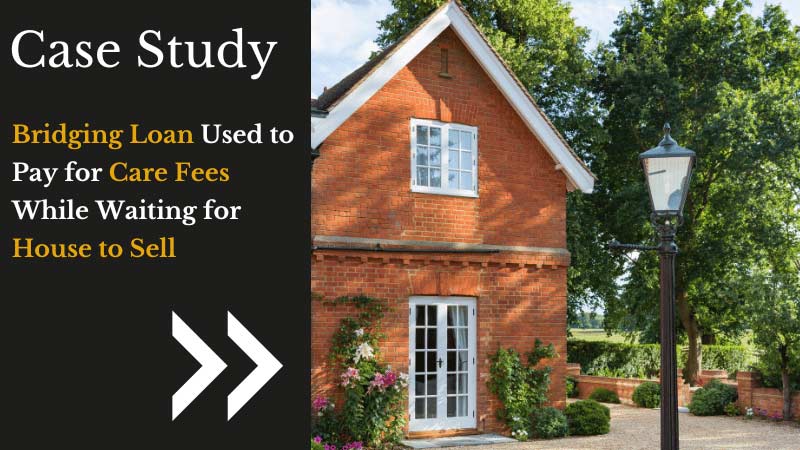What is a bridging loan?
A bridging loan is a short-term loan used to buy property.
They are typically up to 12 months in duration and are repaid when long-term funding is put in place - either via a mortgage, or through the sale of the property or another asset.
For example, bridging loans are often used to buy a new home while you're waiting for your current property to sell - bridging your gap in funding.
They are fast, versatile, short-term property loans used in all kinds of property transactions; from downsizing in retirement, to flipping properties for a profit, to buying property at auction. The use-cases are numerous and varied.
How do bridging loans work?
Bridging loans can be arranged much faster than standard mortgages; however:
- They need to be secured against property (this can be the property you're buying, selling, or both)
- And you must have a verifiable repayment strategy in place (most commonly selling your existing property or getting a mortgage)
Because bridging loans are secured against property, the risks are relatively small to your lender. This means interest rates are fairly low compared to other types of short-term finance.
Interest is calculated and charged monthly; however, if you can pay back your bridging loan early, you'll stop being charged interest on the same day you repay.
Interest can also be 'rolled up' within the loan, so you don't need to worry about monthly payments - instead, you can opt to repay the entire balance (loan and accrued interest) in one lump sum.
Broadly speaking, the main advantages of bridging finance are:
- Large loan sizes: you can borrow up to 80% of the value of your property(s)
- Speed: bridging loans can be arranged in as little as 72 hours in best-case scenarios
- Flexibility: they can be used in a wide range of property scenarios
In many cases, using a bridging loan can mean not having to rush the sale of your house while you buy a new property, and it can also allow you to move quickly in the property market and avoid missing out to cash buyers.
7 Steps to Securing a Bridging Loan [An Example]
John and Helen want to upsize their family home and have found a 5-bedroom detached property on the outskirts of Bristol they've fallen in love with. It's the perfect property in a fantastic location, and comfortably within their price range at £650k.
Their current house is on the market for £450k, but although it's generating some interest, they're yet to receive an offer. They're also going to need a mortgage of £250k, combined with the equity in their current property to complete the purchase, which is proving slow to arrange.
They're starting to get anxious about losing out on the new property from other buyers, especially cash buyers and those who have a healthier property chain and are likely to be more attractive to the seller.
So, they explore the option of a bridging loan.
 Step 1: Explore your options with an adviser
Step 1: Explore your options with an adviser
After some research, they decide to speak to a bridging loan broker to help them understand the process and costs, and see if it's a good idea for their situation. They find Clifton Private Finance, and book a free consultation with an adviser who explains the process and costs from start to finish:
- Yes, a bridging loan could secure the new property - almost straight away.
- The loan could be secured against both properties in the transaction, meaning their loan-to-value (LTV) ratio is low enough to qualify (approximately 75%).
 Step 2: Free quote
Step 2: Free quote
Our broker compares rates across the market from approximately 100 lenders, and finds the best terms available. They then provide a document detailing the exact terms and costs of the bridging loan should they wish to proceed, and talk them through it in detail over the phone. In John and Helen's case, the rates and costs are as follows:
- Their monthly interest rate is 0.8%
- With the size of their loan, this comes to £5,476 per month
- They would be charged this for as many months that they have their bridging loan for - if their house sells and they repay early, they'll stop paying interest immediately
- However, they won't need to make monthly interest repayments - it'll be rolled up into the loan value to all be repaid together
- Their lender's facility fee will be 1.5%, coming to £9,750
- Their lender's admin fee will be £150
- They may have to pay solicitor fees and valuation fees too
- And our broker fee to find the best terms and manage the process from start to finish is £995
 Step 3: Decide if a bridging loan is right
Step 3: Decide if a bridging loan is right
Their estate agent expects their house to sell within 6 months, and not having to drop the price to force a sale means they should receive the full market value for it - and possibly more.
After 6 months, their bridging loan would cost approximately £45,000, and after 12 months approximately £75,000. They're comfortable with the costs, because it means they'll secure the property they've fallen in love with. And the seller even agrees to take £20,000 off the asking price for a quick sale via the bridging loan - they have their sights set on a new property themselves, after all.
 Step 4: Get your Decision in Principle
Step 4: Get your Decision in Principle
John and Helen decide to go ahead, and within 24 hours, their broker sends through their Decision in Principle from the bridging lender. They also send this to the seller's estate agent that day, and follows it up with a call to explain the timescales and strengthen John and Helen's buying position.
 Step 5: Make your offer
Step 5: Make your offer
Their offer is accepted, and their broker talks them through all the paperwork they'll need to provide and sign.
 Step 6: Submit your application
Step 6: Submit your application
Their broker handles the entire application and liaises with the lender, solicitors, surveyors, and the seller's agents throughout the full home buying process - while keeping John and Helen updated every step of the way.
 Step 7: Secure your new property
Step 7: Secure your new property
Two weeks later, with their broker smoothing out any issues in the process, the funds are through, and John and Helen secure their new family home. They have plenty of time for their current property to sell and set up their new mortgage on the other side - which our mortgage advisers at Clifton also help arrange.
Time to pop the champagne!
Watch our video below - Bridging Loans Explained: Costs, Timescales, Examples, & How To Get One:
How much does a bridging loan cost?
There is a range of different costs involved with bridging finance. What your exact bridging loan cost will be depends on the complexity of your case, your loan size, and other factors.
Here’s a list of bridging loan costs and how they work:
- Bridge Loan Interest Rates
- Valuation fee for any properties (we can negotiate a £99 automated valuation option for properties up to £1 million)
- Legal fees (can be around £850)
- Broker fees (typically £995 but varies depending on complexity)
- Facility/arrangement fees (typically 2% gross of the loan)
- Drawdown fee (doesn't always apply but typically £295)
- Exit fees (can be 1.25% of your loan size, but at Clifton Private Finance we try to avoid working with lenders that charge exit fees)
The interest you repay on your bridging loan is calculated as a monthly rate instead of an annual rate, like with a standard mortgage.
This is because you may not hold your bridging loan for a whole year, and most bridging lenders allow you only to pay interest on the months you’ve held your loan if you repay it early.
Because of the short-term nature of bridging finance, interest rates are usually much higher than a typical mortgage, but you only need to pay the rate for a much shorter period.
Your bridge loan rates will be affected by several factors, including:
- Your loan to value ratio (LTV)
- How much do you want to borrow, and for how long (for example, we can source lower rates for bridging loans over £750,000)
- The condition of the property and what you’re planning to do
- Whether it’s a regulated or unregulated bridging loan
- The location of the property
- Your credit history
For more information, please read our complete guide to bridging loan costs.
The bottom line
When weighing up the cost of a bridging loan, the critical thing to remember is how much value the loan can add to your life or business.
If it means you can snap up your dream property and there’s no other alternative, it’s likely more than worth it.
And our clients often find that they entirely cover the cost of their bridging loan from the profit they make on refurbishing their existing property and securing its total value on the market with longer to sell.
Use our free bridging calculator to see how much your property finance could cost.
There are cheap bridging loans out there, and we think it's worth using a broker to help you find them.
Related: Our guide on how to compare lenders and find the best bridging loans.
How much can I borrow with a bridging loan?
You can borrow up to £25m with bridging finance, but it’s typically capped at about 80% of the value of the property you’re using as security.
It's important to note that different lenders have varying policies and criteria regarding the maximum loan amounts they offer for bridging finance. Some lenders have a maximum limit of over £1 million, while others may specialize in smaller loan amounts.
Additionally, the terms and conditions of the loan, including interest rates and fees, should also be taken into consideration when determining the overall affordability of the bridging loan.
For more information, see deposit requirements for bridging loans.
How quickly can I get a bridging loan?
You can get a fast bridging loan within 72 hours.
However, not all bridging loans can be arranged this fast, and it depends on your situation and the properties involved.
You’ll also likely need a broker to push an application through this fast, and it may incur additional fees from your lender and solicitor to expedite your case.
On average, most bridging loans take between 3 to 6 weeks to arrange, and this is a more standard timeframe.
Bridging loan criteria & how to apply
Each bridging loan lender in the UK has its own list of bridging loan criteria that a borrower has to fulfil to qualify for a loan. Some lenders look for low-risk borrowers, while others have niche areas they specialise in and can facilitate.
As a rule, there are two essential criteria you'll need to meet:
- You will need to have a form of security (or deposit for your bridging loan) - usually one or more properties or an asset that the loan can be secured against.
- You will need to have a solid exit strategy to repay the loan. A lender will want to know how you will repay the loan by the end of the agreed term. In most cases, this is either be through selling the property, selling another property, or refinancing with a traditional mortgage loan.
Since the loan is secured against property or other collateral, a lender won't need proof of income. Equally, your credit history won't affect an offer as long as any outstanding debts or adverse credit doesn't impact your ability to repay the loan. However, if you do have a bad credit rating, you may have to pay higher interest rates.
Read our full guide on bad credit bridging loans.
Other basic criteria you will need to fulfil include:
- Minimum age of 18 years old
- You must use the loan to purchase or refurbish residential or commercial property
- Live or have a registered address in the UK (UK expats are eligible for bridge finance in the UK)
Bridging finance is available to individuals and businesses. Loans can be set up for:
- Private individuals
- Limited Companies
- Partnerships
- Offshore companies
If you have any questions about your eligibility for a bridging loan, speak to one of our advisors who will be happy to discuss your situation.
It is fairly common practice to speak to a bridging loan broker for advice on taking out a bridging loan.
You can go direct to lenders, but not all lenders accept direct applicants. Also, most people use a bridging loan broker to guide them through the process, compare rates and get the best deal. Unless you've used bridging products before, we generally don't recommend trying to go direct.
You can book a free, no-obligation call with an adviser below.
9 example uses for bridging loans
1. Residential bridging loans
E.g., a bridging loan to buy a house before selling your home.
This is one of the most common uses of residential bridging finance, and it’s as simple as it sounds.
Buying a new house while selling your current home can be stressful. A considerable amount of administration and various costs are involved, and if something goes wrong, it can amplify the pressure.
Many people choose to use a bridging loan to secure their new house while they wait for their current home to sell for the following reasons:
- Using a bridging loan effectively makes you a cash buyer – this is a great position to be in, and your offer to buy will be attractive to property sellers.
- It gives you 12 months to sell your house – you give your current home time on the market to generate interest and get a great offer.
- This means you don’t have to worry about buyers pulling out.
- And you can even raise more funds than your new purchase value and spend the extra money on some refurbishments to your old property to increase its value before selling.
Here's a detailed example: Bridging Loan For Buying A House: Example Of How It Works
2. Bridging loan to downsize
Using a residential bridging loan to downsize into a smaller property is also an everyday use of bridging finance.
Along with all of the above benefits, you also benefit from raising a lot more than you are buying for, because the property you are securing your loan against will likely be more valuable.
For example, if you are selling your property for £500k and buying for £350k, a bridging lender would happily lend you £500k to be repaid upon the sale of your property, which after buying your new home, would leave you with £150k to fund:
- Moving costs
- Refurbishments on your current home to increase its value
- Any work required on your new home before you move in
- Legal costs and other fees you’ll need to cover throughout your house purchase process
Read our guide on How A Bridging Loan Can Help You Downsize Your Home In Retirement
3. Bridging loan to fix a chain break
If your buyer has pulled out last minute you face losing the new home you have your heart set on, and you need to act fast with a solution.
One of the main advantages of bridging finance is its speed.
With a standard mortgage, your bank needs to ensure you can afford to gradually repay your loan over 25 or 30 years with money you don’t yet have (based on your income, credit score etc.)
The affordability calculations are complex and time-consuming, and there’s a lot of red tape to get through for your underwriter.
However, a bridging loan will be repaid as a lump sum within 12 months from assets you already have – in this case, the property you sell (or with a standard mortgage for which you'll just need a Decision in Principle for your lender).
This means bridging lenders can arrange finance significantly more quickly than a standard mortgage lender.
Our typical time frames for arranging bridging loans are from 2 to 6 weeks, with an average of 3 to 4 weeks, depending on the case's complexity. However, we can raise bridging loans as quickly as 3 working days in some situations.
If you’re unsure if we can meet your tight deadlines, give us a call and speak to a bridging adviser and find out if you need bridging loan advice.
Read our how-to guide on the process: How To Use A Bridging Loan To Buy A House Before Selling
4. Bridging loan to buy an unmortgageable property
What do you do if you’ve found a significant development opportunity but can’t get a mortgage to buy it because of its condition?
If your property is uninhabitable, not wind and watertight, or has structural issues, you may be unable to get a mortgage.
So, if you don’t have the cash to pull together and buy the property outright, a bridging loan is probably your only solution. - but they're designed for exactly this type of transaction.
Property developers frequently use bridging loans to purchase a property that can’t be mortgaged:
A bridging loan secures the property; you have 12 months to develop it up to mortgageable standards. You can then refinance onto a standard property loan (using the mortgage to repay the bridging loan and then repay the mortgage monthly as standard). Or, sell the property you've developed for profit.
Please read our complete guide on this: How to Get Finance to Buy an Uninhabitable Property
5. Bridging loan to buy a property at auction
If you’re buying a property at auction, you must complete the purchase within 28 days.
This time frame is too short for a standard mortgage.
Bridging loans can be arranged quickly under the agreement that you will later refinance with a standard mortgage.
Because your bridging lender knows that you will repay your loan as a lump sum through an entire mortgage, they can release the funds within 28 days in most cases.
You then have 12 months to remortgage your bridging loan to repay the bridge, and often your bridging loan adviser will recommend the right product for you that fits your requirements.
Read our comprehensive guide to property auction finance here
And here's a recent case study of how we helped a client buy a property at auction with a bridging loan:
6. Interest only mortgage bridging loan
Interest only mortgages are often used to purchase large, high-value properties that are typically very unique and/or bespoke to the owner.
This makes them hard to sell, and it can often take 12 months to find a buyer. This is where bridging loans come in.
You can use a bridging loan to fill the gap between when your interest-only mortgage ends and finding a buyer for the property - to buy you more time on your property sale and not have to lower the price and force a sale.
An interest only mortgage bridging loan provides an extra 12 months to your deadline, and you can repay it upon selling your property or other assets.
7. Bridging finance to pay for care fees
Clients often approach us in the difficult situation of arranging for their parents or family members to move into care, and needing short-term finance to cover the costs.
Care fees can be costly, and if your family member doesn’t have the savings to cover the initial costs, on top of moving expenses, it can be challenging to find the money to pay for them.
The long-term solution usually uses the proceeds of the family member’s house sale to cover the ongoing care fees.
However, if they’ve moved into care unexpectedly, you probably won’t have time for the house sale to go through before care fees are due.
And if the property has been lived in for a while, it may need some TLC and refurbishments to get it up to its full market value before selling.
A bridging loan, secured against the property for sale, is the perfect solution to take the stress and pressure away from a delicate situation, creating the space and time for you to focus on the health and comfort of your loved ones rather than financial logistics.
A 12-month bridging loan can be used to pay for any initial care fees, moving costs, and property renovations, and can be repaid when the property sells, giving it plenty of time on the market to receive reasonable offers.
Because the bridging loan is secured against the property, interest rates are much lower than a standard mortgage would charge, and you can borrow much more – at least up to the full value of the property if needed.
Read our full guide for more on bridging loans for care home fees »
Related: Is a bridging loan a good idea? Find out if they're right for you.
And here's a recent case study where we helped our client use a bridging loan to pay for care fees while waiting for their house to sell.
8. Bridging loan to flip a property (bridge to let)
Bridging loans for property development are becoming more popular in the UK.
Whether you’re new to property development or have a portfolio behind your belt, a bridging loan can be a great short-term development funding solution.
For example, you may have significant wealth already - enough to cover the purchase of your new development project – but might not want to liquidate it to make the purchase, especially if you plan to flip the property for a profit after completing your work.
In this case, a bridging loan can secure the property under the condition you sell it before your term ends, and you can carry out your development work and keep the profit on the sale.
For more, here are our services for Short Term Loans For Flipping Houses
We also source bridge to let finance, which enables landlords to secure BTL opportunities and expand their portfolio quickly.
The process is usually comprised of 3 steps:
Step 1: Purchase your development property project with a short-term bridging loan.
Step 2: Use the additional funds raised to complete development work on the property.
Step 3: Sell the property for a profit, covering the fees of bridge financing, the development costs, and your income.
The bridging loans we can arrange have the interest rolled up into the loan's value, which means you don’t have to worry about making monthly interest repayments throughout your loan. Instead, you can protect your cash flow for use on your project.
Here’s our full guide on how to use refurbishment loans to buy and sell a house
9. Bridging loans for commercial development projects
Commercial bridging loans are a slightly different type of bridging finance.
Suppose you’re looking to run a business from your property, and the business profits will fund its mortgage.
The problem is that your business may not be earning enough (or anything at all) yet without the property, so you don't have the income for a commercial mortgage.
In this scenario, a bridging loan can initially secure the property to start the business, and generate income, and you can then refinance later with long term funding.
Here's a step-by-step breakdown:
Step 1: Purchase a property with the potential to generate income with your bridging loan – for example, a property with land on which you can build a series of holiday lets.
Step 2: Include your development finance in the value of your bridging loan to allocate these funds to set up your business on the property – for example, converting 3 vacant buildings into holiday lets.
Step 3: Once the business is up and running and generating income, refinance onto a regular, long-term mortgage to be repaid by the revenue from your company.
For complex scenarios like this, it’s always best to speak to an adviser early on so that we can get an overview of your plans and assess the likelihood of us being able to secure the relevant finance.
Related guide: How to get refurbishment finance for a buy to let property
And here's a real case study where our clients used a bridging loan to secure a property they converted into a holiday let business before refinancing.
We can help with meeting tight deadlines & provide fast and professional bridging loan service.
Call our team on 0117 959 5094 to discuss your requirements or book an appointment.
You can also use our 24/7 enquiry service through live chat - contact us any time, and we'll get back to you as soon as possible - we reply to every message!















